


LDT100x - Learning Theories
Course Dates: May 26, 2025, to July 21, 2025.
This course begins with the foundation: learning theories. In this first module, I’ll walk you through the essential models that shape how we design instruction, from behaviorism and cognitivism to constructivist and social learning perspectives. Understanding these theories changed how I view teaching, learning, and content design—and I’m excited to share that with you.
Let’s dive in. - Jeffrey McDaniels May 2025
© 2025 SCM Trainer. Licensed under Creative Commons Attribution-NonCommercial 4.0 International (CC BY-NC 4.0). You may share and adapt this content for non-commercial use with proper attribution.
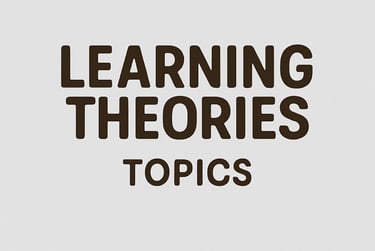

©© 2025 SCM Trainer. Licensed under Creative Commons Attribution-NonCommercial 4.0 International (CC BY-NC 4.0). You may share and adapt this content for non-commercial use with proper attribution.
Image created by ChatCPT from OpenAI
Introduction, Copyright, & the Creative Commons
©© 2025 SCM Trainer. Licensed under Creative Commons Attribution-NonCommercial 4.0 International (CC BY-NC 4.0). You may share and adapt this content for non-commercial use with proper attribution.
Reasons for choosing: CC BY-NC 4.0.
SCM Trainer (my company) uses the Creative Commons Attribution-NonCommercial 4.0 (CC BY-NC 4.0) license to support open access to learning while protecting our content from unauthorized commercial use.
This license allows others to:
Share and adapt our materials
With proper credit to myself and my company, SCM Trainer
For non-commercial purposes only
Why This License
Encourages educational use by instructors, students, and professionals
Protects our intellectual property from being reused in for-profit products
Aligns with our mission to make supply chain learning accessible and affordable
This approach balances openness with ownership, helping us serve the SCM community while maintaining control over the use of our materials.
Just so you know, I have added additional comments in the DSS documents section regarding how my Creative Commons license will change to copyright once we transition to paid and subscription eLearning courses. Check it out under the "Document" page tab.
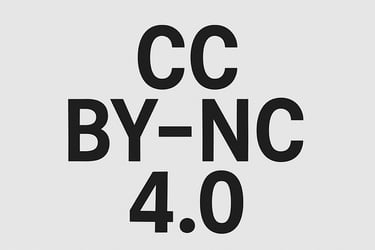

Image created by ChatCPT from OpenAI
Learning Theory: Behaviorism
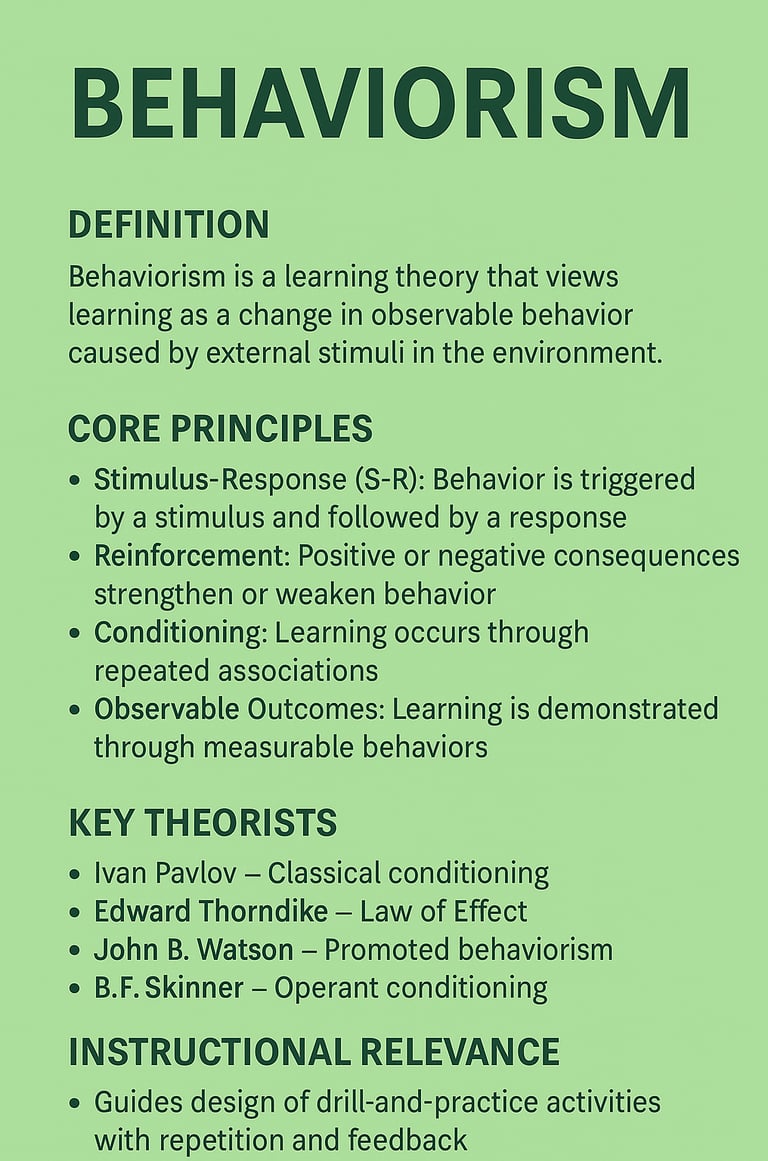

What is Behaviorism?
Behaviorism is a learning theory that views learning as a change in observable behavior shaped by environmental stimuli and responses, without focusing on internal thoughts or emotions.
Key Historical Milestones
1903 – Ivan Pavlov: Discovered classical conditioning through experiments with dogs (stimulus-response associations).
1913 – John B. Watson: Published the article Psychology as the Behaviorist Views It, establishing behaviorism as a formal school of psychology.
1938 – B.F. Skinner: Introduced operant conditioning—behavior is shaped by consequences (reinforcement or punishment).
1950s–1960s – Application in Education: Skinner’s programmed instruction influenced early forms of eLearning and Computer-Assisted Instruction (CAI).
Connection to Teaching and Learning
Emphasizes structured lessons, drill-and-practice, and precise performance objectives.
Observable outcomes, not internal understanding, assess learning.
Most effective for:
Safety/compliance training
Procedural or software tasks
Early-stage or foundational skill development
©© 2025 SCM Trainer. Licensed under Creative Commons Attribution-NonCommercial 4.0 International (CC BY-NC 4.0). You may share and adapt this content for non-commercial use with proper attribution.
Image created by ChatCPT from OpenAI
Implications of Behaviorism for Instructional Design
Behaviorism informs instructional designers to:
Define learning objectives behaviorally – e.g., “Learner will select the correct part number from the WMS interface with 100% accuracy.”
Sequence learning content logically, through chaining and scaffolded steps.
Use frequent assessments, such as multiple-choice, matching, or drag-and-drop.
Provide immediate feedback – correct = positive reinforcement, incorrect = retry or hint.
Incorporate gamification and automation – points, badges, or pass/fail logic within LMS courses.
Use repetition and drill tasks – especially for SOP or compliance mastery.
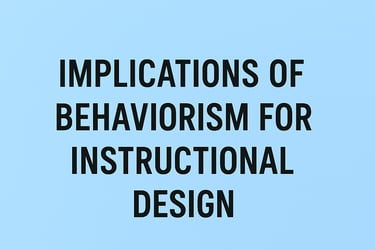

©© 2025 SCM Trainer. Licensed under Creative Commons Attribution-NonCommercial 4.0 International (CC BY-NC 4.0). You may share and adapt this content for non-commercial use with proper attribution.
Image created by ChatCPT from OpenAI
Strengths & Limitations of Behaviorism in Training
Strengths
Clear expectations and alignment with job roles
Excellent for onboarding, compliance, ERP training, and warehouse SOPs
Easily measured and scaled
Learners receive reinforcement that builds confidence
Automation-friendly: feedback, scoring, and remediation are built into the platform
Limitations
Doesn’t support critical thinking or innovation
Learners may become passive recipients, not problem-solvers
Not ideal for developing soft skills, leadership, or ethical reasoning
May overlook motivation and prior knowledge
My Professional Perspective:
As an instructional designer creating training for global supply chain professionals, I’ve found behaviorism extremely effective for task-based training, like using supply chain planning software, practicing safety protocols, or performing root cause analysis with checklists. But I lean heavily on constructivism and cognitive learning strategies when developing strategic thinking or managing ambiguity.
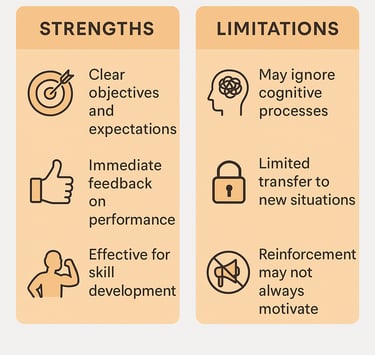

©© 2025 SCM Trainer. Licensed under Creative Commons Attribution-NonCommercial 4.0 International (CC BY-NC 4.0). You may share and adapt this content for non-commercial use with proper attribution.
Image created by ChatCPT from OpenAI
Example of a Behaviorist Learning Scenario
Scenario: "Warehouse Safety Protocol Training"
The Problem: New hires, as well as those in refresher training, in a distribution center often overlook critical steps in the forklift safety protocol. This leads to near misses and non-compliance with OSHA guidelines.
Learning Objective (Behavioral): Given a virtual forklift operation environment, learners will correctly identify and complete all seven steps of the pre-operation safety checklist with 100% accuracy.”
Stimulus-Response Structure:
Stimulus: A simulation screen presents the forklift with hotspots for each safety step (e.g., seatbelt check, horn test).
Response: Learner clicks each item in correct order and completes actions (e.g., horn button press).
Observable Behavior: Sequence completion, timing, and correct response rate are tracked.
Reinforcement Strategy
Positive Reinforcement:
Digital badge unlocked after correct completion
Access to the “Quick Pass” certification for job readiness
Visible progress bar showing safety mastery
Negative Reinforcement:
If the learner completes all steps correctly, they skip a final review module (removal of redundant content).
Incorrect attempts result in additional practice drills and delayed certification.
Observable Evidence of Learning
100% score on simulation
Less than 3 minutes to complete the task
Final quiz with drag-and-drop sequence match = 100% correct
©© 2025 SCM Trainer. Licensed under Creative Commons Attribution-NonCommercial 4.0 International (CC BY-NC 4.0). You may share and adapt this content for non-commercial use with proper attribution.
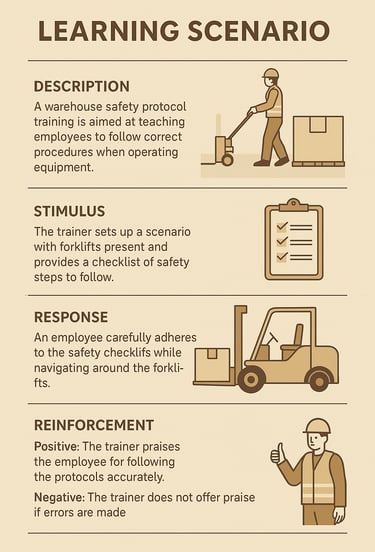

Image created by ChatCPT from OpenAI
Applying Behaviorism in eLearning and vILT
I have added further comments in the Document tab, highlighting how I will apply behaviorism in my eLearning and vILT courses.
Instructional Design Central (IDC). (2024). Learning theories overview. https://www.instructionaldesigncentral.com/learning-theories-overview
Your eLearning World. (n.d.). 4 ways to apply behaviorism principles to your eLearning material. https://yourelearningworld.com/how-to-apply-behaviorism-principles-to-elearning/
Association for Talent Development (ATD). (n.d.). Key adult learning theory concepts and application tips (templates). https://www.td.org/templates-and-tools/adult-learning-theory
Association for Talent Development (ATD). (2019, January). Adult learning – Theory in practice [Video]. https://www.td.org/videos/adult-learning-theory-in-practice
Additional Sources:


©© 2025 SCM Trainer. Licensed under Creative Commons Attribution-NonCommercial 4.0 International (CC BY-NC 4.0). You may share and adapt this content for non-commercial use with proper attribution.
Learning Theory: Cognitivism
Overview of Cognitivism
Cognitivism is a learning theory that emerged between the 1950s and 1970s as a response to the limitations of behaviorism. It highlights the internal mental processes involved in learning, including perception, memory, attention, and problem-solving. Learners are viewed as active processors of information who construct knowledge based on their prior experiences and mental frameworks.
Key researchers and their contributions:
Jean Piaget (1950s–1970s): Proposed four stages of cognitive development and emphasized discovery learning.
Lev Vygotsky (1930s, published posthumously): Introduced the Zone of Proximal Development (ZPD) and the importance of social interaction and scaffolding.
Jerome Bruner (1960s–1990s): Promoted spiral curriculum, discovery learning, and the use of multiple modes of representation.
Albert Bandura (1970s–present): Developed social cognitive theory, integrating cognition and social modeling through self-efficacy and observational learning.
John Sweller (1980s–present): Created Cognitive Load Theory, focusing on the limitations of working memory in instructional design.
Cognitivism relates to teaching and learning by shifting the focus from stimulus-response to how learners encode, store, and retrieve information. Instruction based on this theory emphasizes scaffolding, chunking, concept mapping, and activating prior knowledge to promote deeper understanding.
©© 2025 SCM Trainer. Licensed under Creative Commons Attribution-NonCommercial 4.0 International (CC BY-NC 4.0). You may share and adapt this content for non-commercial use with proper attribution.


Relevance to Instructional Design
Cognitivism provides a foundational framework for designing instruction that supports how learners process, store, and retrieve information. It views learning as an internal, active process and assumes that learners bring prior knowledge and cognitive strategies.
In instructional design, cognitivist principles guide how we:
Structure content logically to reduce confusion.
Activate existing knowledge to help learners connect the new with the known.
Sequence instruction from simple to complex (scaffolding).
Use visuals and multimedia to improve mental model formation.
Support metacognition through reflection and feedback opportunities.
By understanding how the brain functions during learning, instructional designers can create more engaging, memorable, and effective materials.
©© 2025 SCM Trainer. Licensed under Creative Commons Attribution-NonCommercial 4.0 International (CC BY-NC 4.0). You may share and adapt this content for non-commercial use with proper attribution.
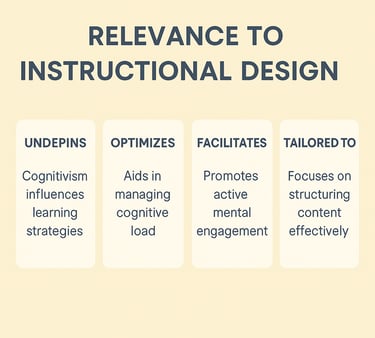

©© 2025 SCM Trainer. Licensed under Creative Commons Attribution-NonCommercial 4.0 International (CC BY-NC 4.0). You may share and adapt this content for non-commercial use with proper attribution.
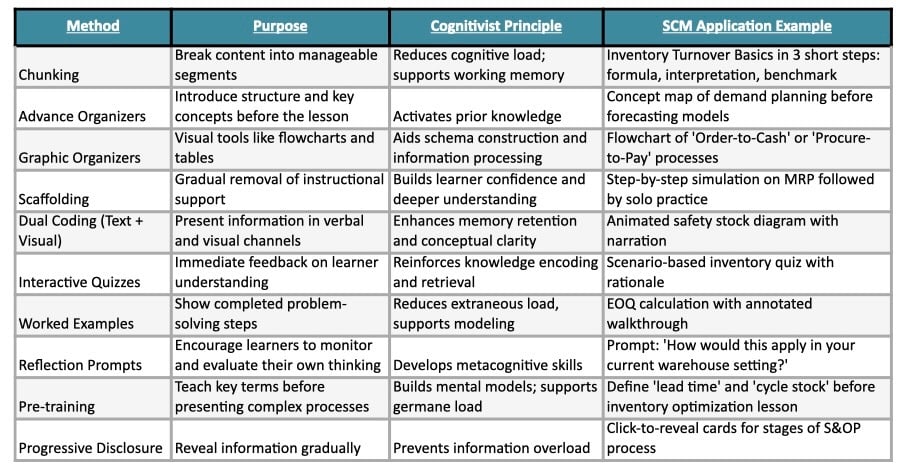

©© 2025 SCM Trainer. Licensed under Creative Commons Attribution-NonCommercial 4.0 International (CC BY-NC 4.0). You may share and adapt this content for non-commercial use with proper attribution.
Strengths and Limitations of Cognitivism in Corporate Training
Strengths:
In a corporate learning environment, particularly in supply chain training, cognitivism is effective as it promotes step-by-step skill development, problem-solving, and knowledge transfer. It allows designers to create training that aligns with the mental models used in decision-making (e.g., planning inventory or optimizing logistics). Employing schema activation and chunked job aids results in faster onboarding and improved retention.
Limitations:
Cognitivism often underestimates the emotional and motivational factors that influence adult learners. It may also not fully support collaborative or contextual learning without integrating constructivist or social learning theories. Real-world constraints, such as limited time and learner resistance, can challenge the application of layered scaffolding or detailed prior knowledge activation in fast-paced environments.


©© 2025 SCM Trainer. Licensed under Creative Commons Attribution-NonCommercial 4.0 International (CC BY-NC 4.0). You may share and adapt this content for non-commercial use with proper attribution.
Summary:
Cognitivism is a robust theory for instructional designers seeking to provide clear, organized, and learner-centered instruction. It is particularly effective when:
Teaching complex concepts (e.g., supply chain planning, programming).
Developing self-paced eLearning or job aids.
Designing instruction that requires retention and transfer.
However, it is most effective when combined with other theories, such as constructivism or social learning, to address motivation, collaboration, and contextual knowledge.
What's in it for the Learner in my eLearning courses:
Here’s how my courses utilizing Cognitivism will work for them (my learners):
No Fluff, Just Focus: Content is broken down into bite-sized modules so you’re never overwhelmed—each lesson builds logically on the last.
It Starts With What You Know: We tap into your existing experience in supply chain to help you make sense of new information faster.
Visuals + Voice = Better Recall: You’ll learn with charts, voiceovers, and animations that make complex topics like forecasting, inventory, or lead time variability easier to grasp.
Built for On-the-Job Use: What you learn here isn’t theory—it’s directly applicable to the problems you face every day in planning, sourcing, or logistics.
Practice That Sticks: With real examples, knowledge checks, and reflection prompts, you don’t just “get it”—you retain it and can use it again.
Bottom Line for my perspective:
Cognitivism is an ideal foundation for SCM Trainer’s content-rich, structured mini-courses. It ensures learners process complex supply chain information efficiently, particularly when applying principles such as chunking, schema-building, and worked examples. However, to achieve maximum engagement and behavioral change, SCM Trainer should incorporate motivational design, social learning features, and authentic decision-making scenarios drawn from real supply chain contexts.
©© 2025 SCM Trainer. Licensed under Creative Commons Attribution-NonCommercial 4.0 International (CC BY-NC 4.0). You may share and adapt this content for non-commercial use with proper attribution.
Web-Based Microlearning
Title: Logistics Management Training Module
Creator: Alison Online Learning (free registration required)
https://alison.com/courses?query=Logistics Management Training Module
Go to Module 1 → Lesson: Logistics and Supply Chain Management Overview
Overview:
This introductory microlearning module from Alison provides a text-based overview of logistics and supply chain management fundamentals. Learners progress through short sections that explain concepts like logistics flow, functions of warehousing, and SCM objectives. The design includes visuals, bullet points, and a short quiz to reinforce comprehension—ideal for learners new to supply chain roles.
Why it's useful:
Strengths:
Solid chunking and clarity: Each micro-topic reads 2–3 minutes.
Suitable for schema development in foundational topics.
Integrated low-stakes quizzes promote active retrieval.
Limitations:
It lacks real-world problem-solving, which would enhance the germane load.
Static visuals may limit engagement for visual or auditory learners.


Learning Theory: Constructivism
Overview of Constructivism
Constructivism is a theory of learning that posits individuals do not passively absorb information but actively construct knowledge through experience, reflection, and social interaction. Learning is a meaning-making process where the learner builds new mental models by interpreting new experiences through prior knowledge.
Constructivism isn’t a single theory—it spans cognitive (Piaget) and social (Vygotsky, Lave & Wenger) branches, but all emphasize that learning is active, contextual, and personal.
Key Dates & Theorists:
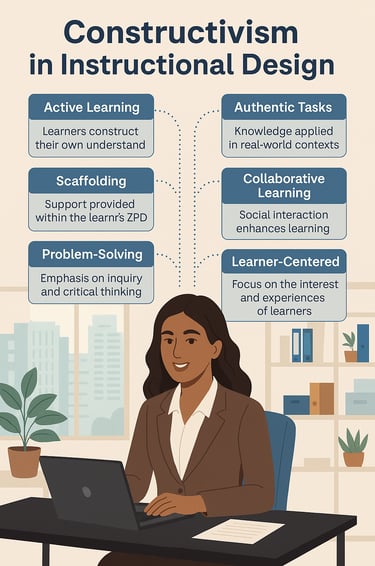

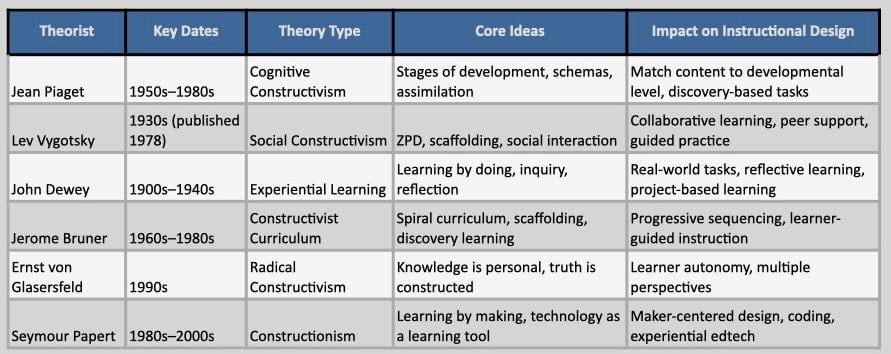

Connection to Learning:
Learning is not passive absorption—it’s active exploration. Learners connect new ideas to prior knowledge and construct meaning through tasks, collaboration, and reflection.
©© 2025 SCM Trainer. Licensed under Creative Commons Attribution-NonCommercial 4.0 International (CC BY-NC 4.0). You may share and adapt this content for non-commercial use with proper attribution.
Learning Theory: Constructivism
🎯Implications for Instructional Design
Shift from content delivery to learning experience design
Prioritize authentic, real-world tasks (e.g., simulations, case studies)
Design with ZPD and scaffolding in mind
Use tools that foster collaboration (discussion boards, group projects, co-creation)
Emphasize learner reflection, feedback loops, and formative assessment.
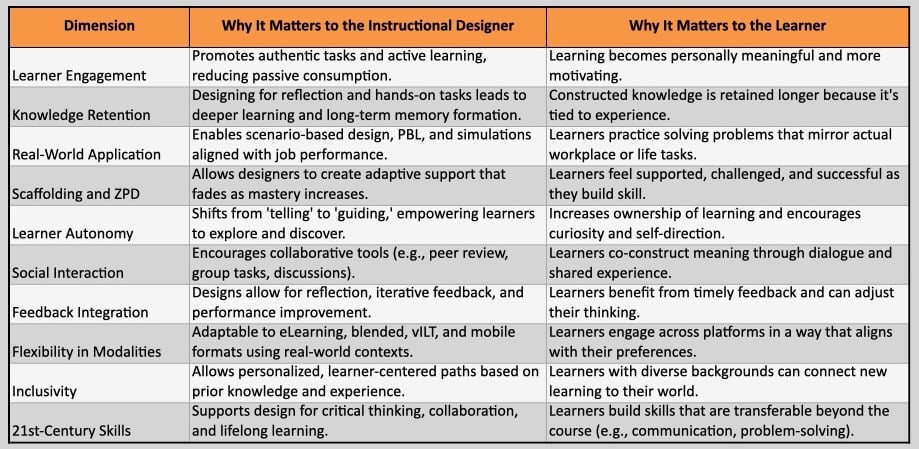

©© 2025 SCM Trainer. Licensed under Creative Commons Attribution-NonCommercial 4.0 International (CC BY-NC 4.0). You may share and adapt this content for non-commercial use with proper attribution.
Learning Theory: Constructivism
✅ Strengths:
Encourages real-world application (e.g., forecasting challenges, supplier negotiation)
Boosts engagement and retention through role-based scenarios
Promotes teamwork, reflective practice, and systems thinking
❌ Limitations:
Requires strong facilitation to prevent learner confusion
Time-intensive design and rollout process
Not all corporate learners are comfortable with open-ended or ambiguous learning tasks
Additional Concerns:
Cultural Constructivism: The influence of culture and identity in shaping knowledge construction.-
Technology-Enhanced Constructivism: A deep dive into digital tools that support constructivist learning (e.g., simulations, collaborative platforms, generative AI, AR/VR).
Assessment in Constructivist Design: Strategies for authentic, formative, and performance-based assessments aligned with constructivist principles.
Cognitive Load Considerations - how to manage cognitive overload in constructivist tasks, especially for novices.
Constructivism in Workplace Learning / Adult Education: Application of constructivism for adult learners, professional training, and informal learning contexts.
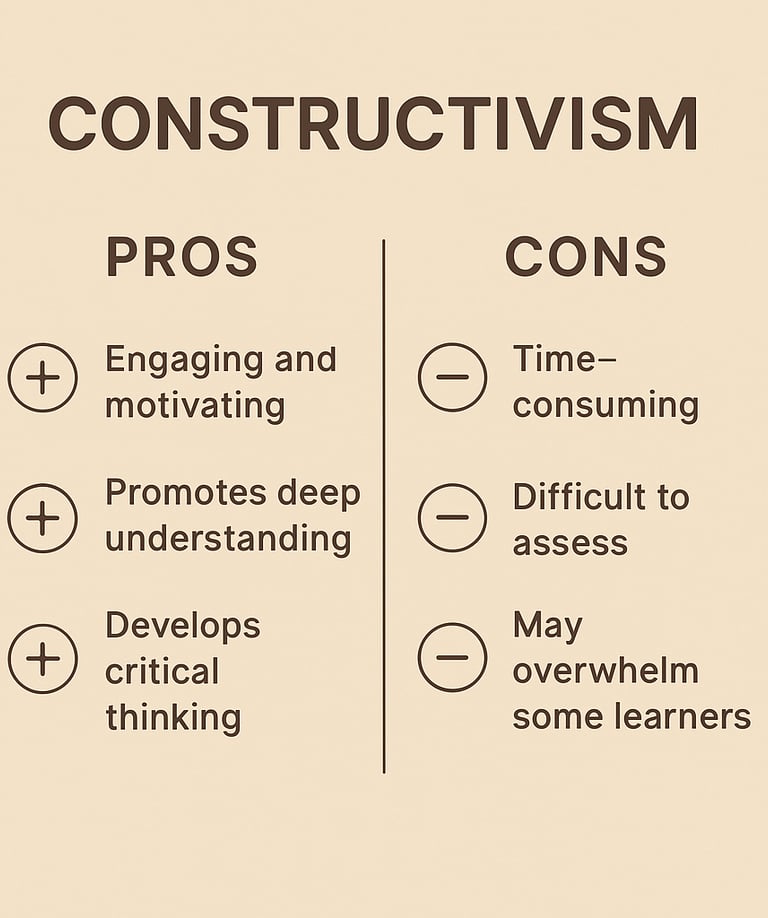

©© 2025 SCM Trainer. Licensed under Creative Commons Attribution-NonCommercial 4.0 International (CC BY-NC 4.0). You may share and adapt this content for non-commercial use with proper attribution.
Learning Theory: Constructivism
Topic: “Fixing a Broken Forecast”
Scenario:
Learners are supply chain analysts in a global consumer goods company. They receive a report showing a significant gap between forecast and actual demand. In teams, they:
Analyze historical sales data
Interview virtual team members (simulated chatbot or role-play prompts)
Develop a revised forecast and recommend corrective actions
Present their findings to a simulated S&OP team for feedback
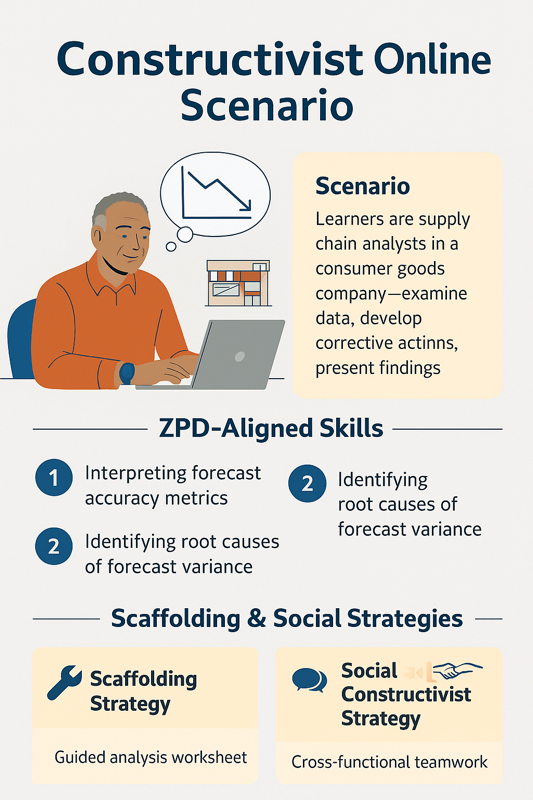

©© 2025 SCM Trainer. Licensed under Creative Commons Attribution-NonCommercial 4.0 International (CC BY-NC 4.0). You may share and adapt this content for non-commercial use with proper attribution.
Learning Theory: Constructivism
Zone of Proximal Development (ZPD, i.e. the“sweet spot” for learning)—Aligned Skills
It refers to the range of tasks that a learner cannot yet do independently, but can accomplish with guidance, support, or collaboration. For example:
Outside ZPO - Too hard even with help.
Within ZPD - Achievable with guidance.
Already mastered - Can do independently.
Instructional Design Application:
Why It Matters:
Learning is most effective when we target activities within the learner’s ZPD—not too easy, not too hard.Design Implication:
We provide scaffolding (like prompts, feedback, job aids, or modeling) that supports the learner until they can complete the task independently.Example:
In a supply chain course, asking learners to analyze multi-channel forecast bias may be outside their current ability, but if we give them a case study, a formula guide, and a walkthrough video, they can do it. That’s ZPD in action.
PE - These skills lie just outside the learners’ independent ability but can be mastered with support:
Interpreting forecast accuracy metrics (e.g., MAPE, bias)
Identifying root causes of forecast variance
Creating a corrective action plan with stakeholder alignment


©© 2025 SCM Trainer. Licensed under Creative Commons Attribution-NonCommercial 4.0 International (CC BY-NC 4.0). You may share and adapt this content for non-commercial use with proper attribution.
Learning Theory: Constructivism
Scaffolding & Social Strategies
Scaffolding Strategy:
Provide a step-by-step forecast analysis worksheet with examples
Offer “hints” embedded in the LMS that appear based on learner choices
Include a dashboard showing progress against each required task
Social Constructivist Strategy:
Learners work in cross-functional teams using a shared whiteboard (e.g., Miro, Mural)
Encourage peer teaching through structured debate over forecast causes
Use rotating team roles: data analyst, demand planner, presenter
Differentiation Considerations:
Provide optional job aids or cheat sheets for learners unfamiliar with Excel or forecasting terminology.
Allow text-based or voice-based participation in group discussions
Embed self-paced review modules for learners who need additional support.
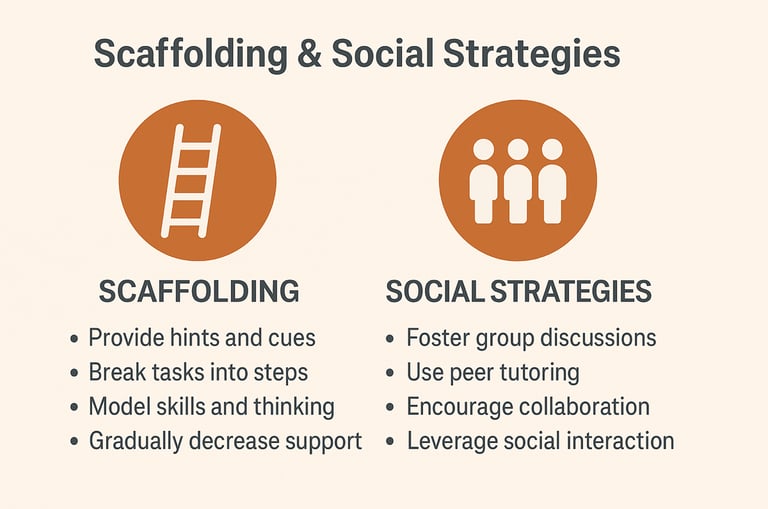

©© 2025 SCM Trainer. Licensed under Creative Commons Attribution-NonCommercial 4.0 International (CC BY-NC 4.0). You may share and adapt this content for non-commercial use with proper attribution.
Learning Theory: Constructivism
Quick Reflection:
Constructivism hit differently this time around. It reminded me that significant learning isn’t about dumping content but designing experiences where people build knowledge for themselves.
As someone who designs training for supply chain pros, I’ve seen firsthand that nothing sticks like real-world scenarios and hands-on problem solving. That’s the heart of constructivism—and it works.
It also reminded me that my job isn’t to deliver answers, but to build learning environments that guide, challenge, and support. That shift—from expert to learning architect—feels right.
✏️ My Takeaways:
Learners thrive when they connect learning to their world.
Scaffolding is non-negotiable.
Real learning happens when we step back and let learners take the wheel.
Constructivism isn’t just a “just” a theory—it’s a mindset shift. And for me, it’s a refreshing reminder of what powerful learning looks like.
JB Mac


©© 2025 SCM Trainer. Licensed under Creative Commons Attribution-NonCommercial 4.0 International (CC BY-NC 4.0). You may share and adapt this content for non-commercial use with proper attribution.
Learning Theory: Constructivism
Additional Resources Used:
📰 eLearning Industry (Christina R. Green, 2020) – “Applying Constructivism in eLearning: 6 Practical Tips”
Offers digital design strategies rooted in constructivist principles.
https://elearningindustry.com/applying-constructivism-elearning-6-practical-tips
🎧 Podcast: Transfer and Conceptual Understanding - a conversation with Julie Stern
Offers a guide to learning transfer and tools for teaching conceptual understanding, elementary, and secondary.
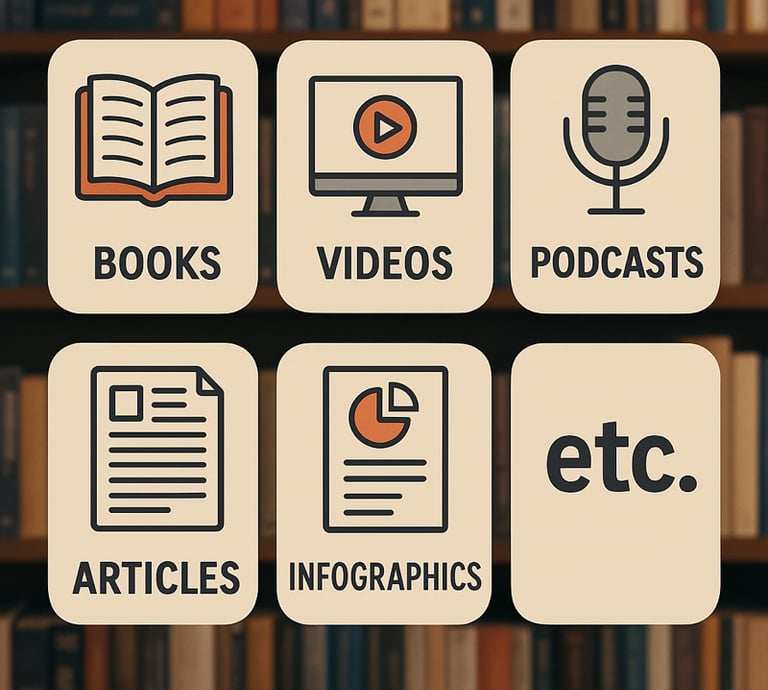

©© 2025 SCM Trainer. Licensed under Creative Commons Attribution-NonCommercial 4.0 International (CC BY-NC 4.0). You may share and adapt this content for non-commercial use with proper attribution.
Learning Theory: Connectivism
Provide an overview of Connectivism.
Write Connectivism, proposed by George Siemens in 2005 and expanded by Stephen Downes, redefines learning as a process of forming connections among sources of information, especially in digital environments. Unlike traditional theories focusing on individual knowledge construction, connectivism emphasizes learning as a networked activity, integrating humans and non-human appliances (e.g., AI tools, databases, social media).
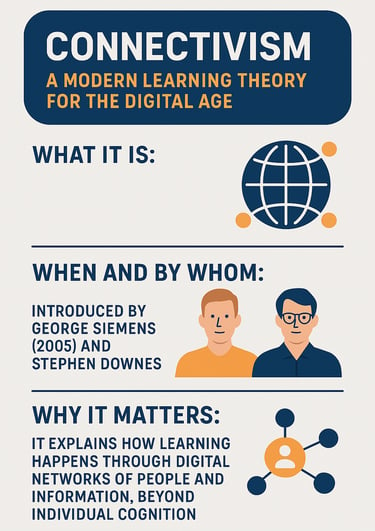

©© 2025 SCM Trainer. Licensed under Creative Commons Attribution-NonCommercial 4.0 International (CC BY-NC 4.0). You may share and adapt this content for non-commercial use with proper attribution.
Learning Theory: Connectivism
Implications for instructional design.
Recommendations:
Highlight the designer’s role as a network builder.
Emphasize learning environments that support:
Peer-to-peer exchange
Use of social media and collaborative platforms
Microlearning and just-in-time learning
Examples to use:
In eLearning design, use Slack or discussion boards to support knowledge sharing.
Create assignments where learners curate and evaluate resources from their PLN (Personal Learning Network).
Incorporate tools like Flip, Padlet, or Miro to visualize learner connections.
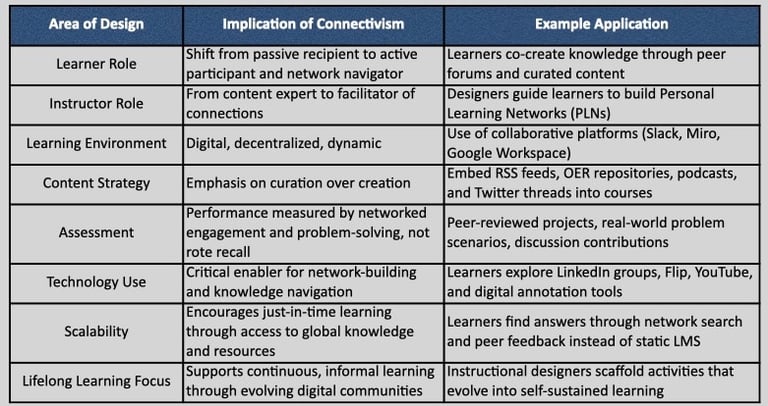

©© 2025 SCM Trainer. Licensed under Creative Commons Attribution-NonCommercial 4.0 International (CC BY-NC 4.0). You may share and adapt this content for non-commercial use with proper attribution.
Learning Theory: Connectivism
Strengths and limitations of Connectivism in my context - For SCM Trainer / Corporate L&D:
In corporate training, connectivism excels when applied to continuous professional development. It empowers learners to tap into real-time resources, experts, and global peers. However, its reliance on learner initiative and digital fluency may pose a challenge in hierarchical or compliance-heavy organizations.
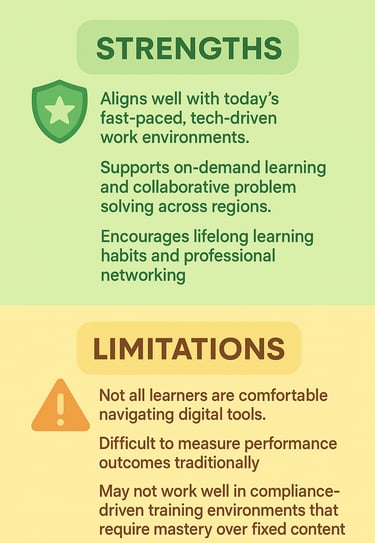

©© 2025 SCM Trainer. Licensed under Creative Commons Attribution-NonCommercial 4.0 International (CC BY-NC 4.0). You may share and adapt this content for non-commercial use with proper attribution.
Learning Theory: Connectivism
Build your Personal Learning Network (PLN)
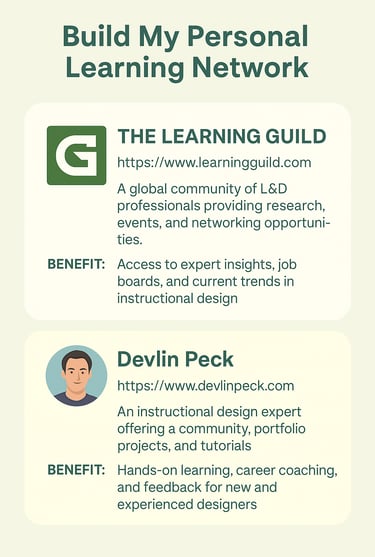

The two PLNs on the infographic are two new networks that I plan to join that parallel my interest in both my instructional design + supply chain training interests:
Two other professional organizations that I belong to have multi-layered PLN structures:
The Association for Talent Development (ATD) offers a multi-layered PLN structure—from formal cohort engagement and alums networks to grassroots chapter connections and strategic online discussions. For designers like you at SCM Trainer, leveraging all three layers can offer global insights, local peer support, and practical tools to drive ongoing excellence in supply chain training. (www.td.org)
The ASCM (Association for Supply Chain Management) offers another powerful avenue for building a Personal Learning Network (PLN), especially for professionals at the intersection of instructional design and supply chain training. (www.ascm.org)
©© 2025 SCM Trainer. Licensed under Creative Commons Attribution-NonCommercial 4.0 International (CC BY-NC 4.0). You may share and adapt this content for non-commercial use with proper attribution.
Learning Theory: Connectivism
Benefits of integrating them into my PLN
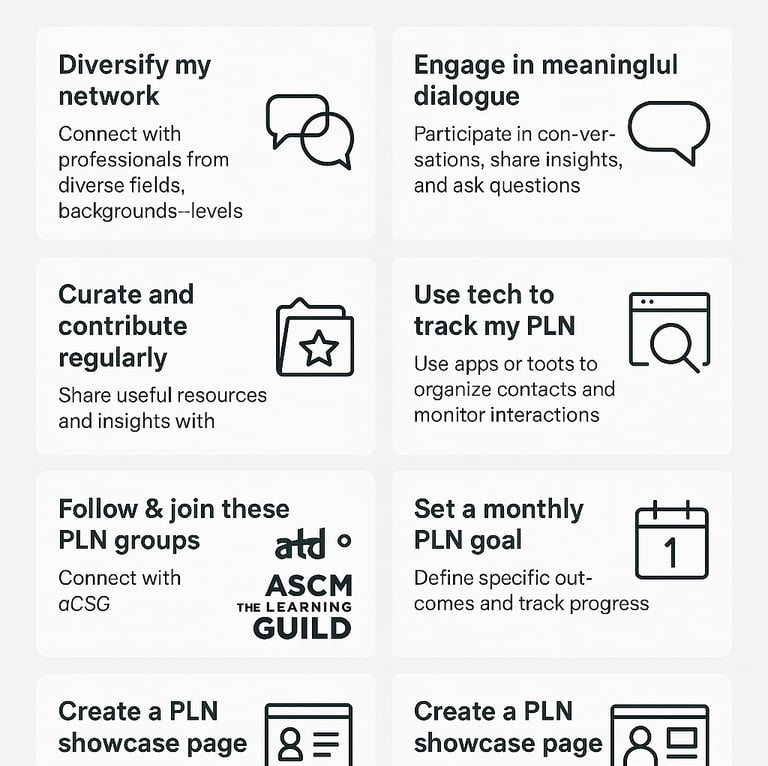

By following the Learning Guild, I stay current with research-backed instructional design trends and attend events featuring experts. Through Devlin Peck’s community, I engage in project-based learning and receive targeted feedback, which enhances my practical skills and network reach. These points are also applicable to my ATD and ASCM PLN. These are suggested actions and talking points:
©© 2025 SCM Trainer. Licensed under Creative Commons Attribution-NonCommercial 4.0 International (CC BY-NC 4.0). You may share and adapt this content for non-commercial use with proper attribution.
Learning Theory: Connectivism
Resources for my Additional Study of Connectivism


Siemens, G. (Speaker). (2014). Connectivism: A Learning Theory for the Digital Age [Video]. EDUCAUSE Learning Initiative.
https://www.youtube.com/watch?v=Rz4sOGn3Q9oHelmer, J. (Host). (2023, March). Networked Learning and the Future of L&D [Audio podcast episode]. In The Learning Hack Podcast.
https://learninghackpodcast.comDownes, S. (2024). Stephen Downes’ OLDaily [Blog].
https://www.downes.ca
©© 2025 SCM Trainer. Licensed under Creative Commons Attribution-NonCommercial 4.0 International (CC BY-NC 4.0). You may share and adapt this content for non-commercial use with proper attribution.
Learning Theory: Andragogy
Andragogy is the theory and practice of adult learning, coined from the Greek word andr (man) and agogos (leading), meaning “the art and science of helping adults learn” (Knowles, 1984). It contrasts with pedagogy (child-focused education), emphasizing autonomy, relevance, and experiential learning.
Originally formalized by Malcolm Knowles, andragogy evolved through the 1970s and 1980s into a foundational theory widely applied in workplace training, higher education, and instructional design—particularly within eLearning environments.
Malcolm Knowles was an American educator best known for popularizing the concept of andragogy—the theory and practice of adult learning. He identified key characteristics that distinguish adult learners from children, emphasizing self-direction, life experience, readiness to learn, and immediate application. His work laid the foundation for modern adult education and remains a cornerstone in instructional design, especially in workplace and professional training contexts.
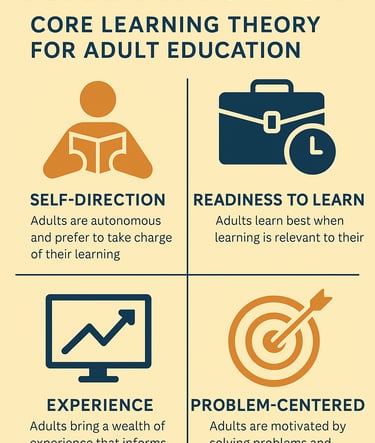

©© 2025 SCM Trainer. Licensed under Creative Commons Attribution-NonCommercial 4.0 International (CC BY-NC 4.0). You may share and adapt this content for non-commercial use with proper attribution.
Learning Theory: Andragogy
Knowles’ Five Assumptions of Adult Learners
Self-concept: Adults become self-directed as they mature.
Experience: Adults bring life experiences that serve as a valuable resource.
Readiness to Learn: Adults are ready to learn things that align with their roles.
Orientation to Learning: Adults are problem-centered and goal-oriented.
Motivation to Learn: Internal motivators (e.g., job growth, satisfaction) outweigh external ones
A sixth assumption added later: Need to Know – Adults need to understand why they should learn something before engaging.
©© 2025 SCM Trainer. Licensed under Creative Commons Attribution-NonCommercial 4.0 International (CC BY-NC 4.0). You may share and adapt this content for non-commercial use with proper attribution.
Learning Theory: Andragogy
Six Core Principles of Andragogy
Learner Involvement – Engage adults in planning and evaluation of their instruction.
Experience Utilization – Connect new content to learners' prior knowledge.
Immediate Relevance – Prioritize content applicable to professional/personal life.
Problem-Solving Orientation – Use task-based learning, not subject-centered content.
Autonomy and Flexibility – Let learners control pace, pathway, and goals.
Internal Motivation – Design learning to appeal to pride, job performance, and personal growth
©© 2025 SCM Trainer. Licensed under Creative Commons Attribution-NonCommercial 4.0 International (CC BY-NC 4.0). You may share and adapt this content for non-commercial use with proper attribution.
Learning Theory: Andragogy
Applying Andragogy in Instructional Design
Instructional designers can effectively integrate andragogical principles by:
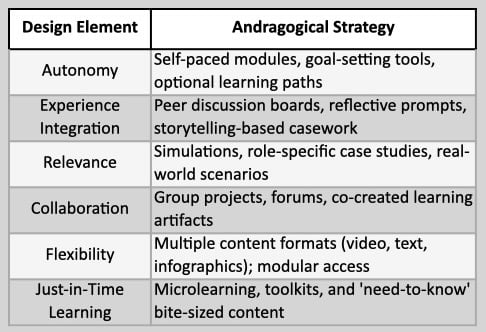

Example: In a logistics training course, let learners choose between video case studies on route optimization or warehouse layout planning, leading to the same objective but tailored to different roles.
©© 2025 SCM Trainer. Licensed under Creative Commons Attribution-NonCommercial 4.0 International (CC BY-NC 4.0). You may share and adapt this content for non-commercial use with proper attribution.
Learning Theory: Andragogy
Andragogy offers a powerful framework for designing adult learning experiences, especially in corporate settings. Its strengths lie in promoting self-directed, experience-based, and problem-centered learning—key traits of working professionals. When applied effectively, it supports autonomy, relevance, and real-world application, making learning more engaging and impactful.
At SCM Trainer, we see this in action every day. Learners thrive when they can apply what they learn to solve operational challenges—like improving forecast accuracy or reducing inventory costs—using tools and scenarios drawn directly from their work.
However, andragogy isn’t without its challenges. Not all adult learners are naturally self-directed, especially when new to a role or topic. Foundational skills, compliance content, and digital literacy gaps often require more structure and support. Additionally, measuring ROI and learning impact can be difficult without clear performance links.
The key is balance—blending learner autonomy with scaffolded support, real-world context, and authentic assessments. When thoughtfully applied, andragogy doesn’t just support adult learning—it empowers it.
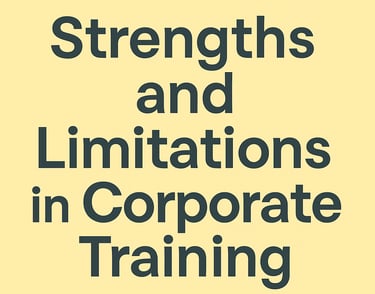

©© 2025 SCM Trainer. Licensed under Creative Commons Attribution-NonCommercial 4.0 International (CC BY-NC 4.0). You may share and adapt this content for non-commercial use with proper attribution.
Learning Theory: Andragogy
Challenges and Considerations When Applying Andragogy
While andragogy is effective, it’s not universal. Here are key challenges to keep in mind:
Not all adults are self-directed. Some learners need more structure and guidance, especially when new to a topic or environment.
It’s less effective for foundational learning. Beginners may struggle without clear instruction before applying concepts.
Motivation varies. Internal drive isn’t always enough—learners need clear relevance and value.
Compliance and regulatory training require structure. Flexibility may be limited by mandated content or timelines.
Digital literacy gaps exist. Tech-heavy formats may alienate less experienced users.
Cultural and generational differences matter. Some learners prefer structure and instructor presence.
ROI and learning impact can be hard to measure. Problem-based approaches don’t always produce standard metrics.
Effective design blends andragogical principles with structure, flexibility, and support to meet diverse learner needs.
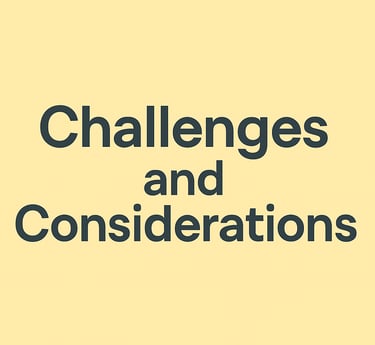

©© 2025 SCM Trainer. Licensed under Creative Commons Attribution-NonCommercial 4.0 International (CC BY-NC 4.0). You may share and adapt this content for non-commercial use with proper attribution.
Learning Theory: Andragogy
Why Andragogy Is Essential to SCM Trainer’s eLearning Courses
At SCM Trainer, our learners are mid-level professionals seeking practical, job-ready skills. Andragogy is essential because it aligns perfectly with how adult learners want to learn—autonomously, purposefully, and with immediate relevance. Here’s how it fits:
Self-Directed Learning
Our modular, self-paced courses let learners choose what they need and when needed.Experience-Based Design
We use real-world scenarios and case studies that connect directly to learners’ daily challenges.Problem-focused content
Courses are built around solving practical supply chain issues, not abstract theory.Internal Motivation
Learners gain tools to improve job performance, earn credentials, and drive results—powerful motivators.Flexible and Mobile-Friendly
Content is available in short, focused units—ideal for busy professionals balancing multiple priorities.


©© 2025 SCM Trainer. Licensed under Creative Commons Attribution-NonCommercial 4.0 International (CC BY-NC 4.0). You may share and adapt this content for non-commercial use with proper attribution.
Learning Theory: Andragogy
My Learning Preferences – Informal and Non-Formal Learning
As a lifelong learner and a dual professional in supply chain and instructional design, I thrive in informal and non-formal learning environments. These formats give me the flexibility to learn on demand, focus on what matters most in the moment, and apply new knowledge immediately to both client work and course development.
Informal learning happens organically throughout my week. I read blogs, listen to instructional design and supply chain podcasts, watch YouTube walkthroughs, and explore new tools like ChatGPT and Articulate 360 AI. I also engage in meaningful conversations with peers through LinkedIn—sharing, learning, and reflecting in real time. This self-directed learning keeps me agile and constantly evolving.
Non-formal learning adds valuable structure and progression without the rigidity of traditional schooling. I actively pursue targeted professional development through:
ATD mini-courses to deepen my expertise in talent development strategy, adult learning, and instructional facilitation.
MicroMasters and specialization programs in supply chain management on platforms like Coursera and edX to stay current with best practices and emerging strategies across logistics, forecasting, and supply chain analytics.
APICS certificate courses focused on specialized areas such as planning, warehousing, procurement, and supply chain resilience, complementing my full suite of APICS certifications.
These learning choices directly reflect andragogical principles: self-direction, goal orientation, experiential integration, and immediate relevance to my personal and professional goals.
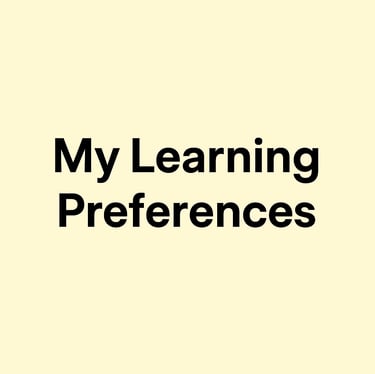

©© 2025 SCM Trainer. Licensed under Creative Commons Attribution-NonCommercial 4.0 International (CC BY-NC 4.0). You may share and adapt this content for non-commercial use with proper attribution.
Learning Theory: Andragogy
To sustain relevance and maximize value:
I author original blog content on supply chain leadership, demand planning, instructional design, and AI integration.
I post regularly on LinkedIn, using my large and active network to engage with peers, spark discussions, and share resources.
I speak at webinars, university supply chain groups, and local business forums to mentor professionals and inspire future talent.
I publish all blog posts on SCMTrainer.com, serving as a central hub for applied knowledge and best practices.
I am intentional about reciprocity, amplifying others' voices and contributing to industry conversations.
By aligning my learning preferences with an active contribution mindset, I stay relevant, informed, and connected—while helping others grow.
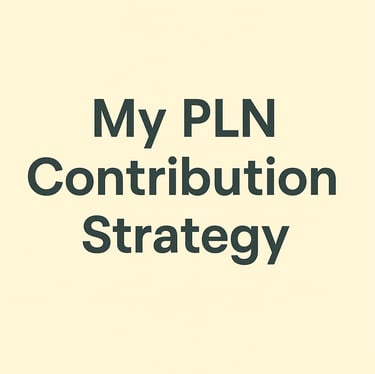

©© 2025 SCM Trainer. Licensed under Creative Commons Attribution-NonCommercial 4.0 International (CC BY-NC 4.0). You may share and adapt this content for non-commercial use with proper attribution.
Learning Theory: Andragogy
Benefits of This PLN Approach
Relevance and Credibility: Posting consistently and speaking publicly ensures I remain a visible and trusted expert in my field.
Scalable Impact: My network reach through LinkedIn, webinars, and SCM Trainer extends globally—benefiting learners, clients, and colleagues.
Learning Through Contribution: Each interaction is an opportunity to reinforce my own growth, reflect critically, and model lifelong learning.
Mentorship and Influence: I regularly receive feedback and engagement from peers, learners, and industry partners—further sharpening my insights.


©© 2025 SCM Trainer. Licensed under Creative Commons Attribution-NonCommercial 4.0 International (CC BY-NC 4.0). You may share and adapt this content for non-commercial use with proper attribution.
Learning Theory: Andragogy
My Reflection
Andragogy is a powerful lens, but not a one-size-fits-all solution. Effective instructional design for adult learners requires strategic blending—leveraging andragogical strengths while addressing learner variability, organizational needs, and content-specific demands.
Smart design means meeting adults where they are, while guiding them where they need to go—with just the right balance of freedom, structure, and support.


©© 2025 SCM Trainer. Licensed under Creative Commons Attribution-NonCommercial 4.0 International (CC BY-NC 4.0). You may share and adapt this content for non-commercial use with proper attribution.
Learning Theory: Andragogy
Books
Brookfield, S. D. (2013). The skillful teacher: On technique, trust, and responsiveness in the classroom (3rd ed.). Jossey-Bass.
Podcasts
Malamed, C. (Host). (n.d.). Adult learning principles in instructional design [Audio podcast episode]. In The eLearning Coach Podcast. Retrieved June 19, 2025, from https://theelearningcoach.com/podcasts/
Blogs
Pappas, C. (n.d.). 9 tips to apply adult learning theory to eLearning. eLearning Industry. Retrieved June 19, 2025, from https://elearningindustry.com/
Scholarly Articles
Henschke, J. A. (2011). Considerations regarding the future of andragogy. Adult Learning, 22(1), 34–37. https://doi.org/10.1177/104515951102200106
Online Resources
Cobb, J. (n.d.). A guide to andragogy. Leading Learning. Retrieved June 19, 2025, from https://www.leadinglearning.com/guide-to-andragogy/


©© 2025 SCM Trainer. Licensed under Creative Commons Attribution-NonCommercial 4.0 International (CC BY-NC 4.0). You may share and adapt this content for non-commercial use with proper attribution.
Learning Theory: Assessment & Learning Models
Learning Scenario
In a corporate supply chain training program titled "Designing Resilient Inventory Strategies", mid-level professionals collaborate in small teams to develop inventory mitigation strategies for a company expanding into three new global markets.
Over three weeks, learners:
Analyze regional sourcing risks and historical inventory data,
Design a risk-adjusted strategy including safety stock buffers, dual sourcing, and KPI metrics,
Present their plan in an executive briefing simulation.
Learning Objectives
LO1: Analyze market-specific inventory risks and design mitigation strategies.
LO2: Collaborate with peers to develop actionable, data-driven inventory plans.
LO3: Present a comprehensive supply chain strategy using professional business communication practices....


©© 2025 SCM Trainer. Licensed under Creative Commons Attribution-NonCommercial 4.0 International (CC BY-NC 4.0). You may share and adapt this content for non-commercial use with proper attribution.
Learning Theory: Assessment & Learning Models
Formative Assessment Design
Type: Structured Checkpoints + Multi-Modal Feedback System
By the end of Week 1, learners submit a draft of their inventory strategy, including key assumptions, risk mitigation concepts, and initial KPIs.
Peer Review:
Small groups use a checklist to assess clarity, feasibility, and objective alignment.
Instructor Feedback:
Delivered through a short Loom video using a focused rubric covering logic, data use, innovation, and completeness.
Purpose:
This low-stakes checkpoint fosters early course correction, encourages critical thinking, and models real-world decision-making. It aligns with constructivist principles by promoting reflection and iterative improvement—boosting learner confidence and final output quality.


Authentic Assessment Design
Type: Final Strategy Pitch + Executive Summary Package
In Week 3:
Teams deliver a 12-minute strategic pitch to a simulated executive board via Zoom or asynchronous video.
Deliverables include:
Executive summary
Visual KPI dashboard
Timeline for rollout
Risk mitigation plan
Rubric Criteria:
Strategic soundness and feasibility
Clarity and professionalism of presentation
Justification using data and tools
Risk analysis and contingency planning
Why it’s authentic:
This mirrors real-world performance expectations of supply chain managers and analysts, requiring both technical analysis and leadership communication skills.


©© 2025 SCM Trainer. Licensed under Creative Commons Attribution-NonCommercial 4.0 International (CC BY-NC 4.0). You may share and adapt this content for non-commercial use with proper attribution.
Learning Theory: Assessment & Learning Models
Instructional Design Theory Link
This scenario integrates:
✔️ Constructivist Learning
Learners build understanding by analyzing complex, real-world problems, collaborating with peers, and generating unique solutions.
✔️ Experiential Learning (Kolb Model)
Learners cycle through:
Concrete experience (strategy building)
Reflective observation (feedback checkpoints)
Abstract conceptualization (revised strategy)
Active experimentation (presentation delivery)


©© 2025 SCM Trainer. Licensed under Creative Commons Attribution-NonCommercial 4.0 International (CC BY-NC 4.0). You may share and adapt this content for non-commercial use with proper attribution.
Learning Theory: Assessment & Learning Models
Technology Integration
Google Sheets for KPI modeling and strategy tracking
Miro for collaborative mind-mapping
Loom or Zoom for recording and delivering presentations
Google Docs for peer feedback using comments
These tools reinforce workplace relevance and asynchronous accessibility.


©© 2025 SCM Trainer. Licensed under Creative Commons Attribution-NonCommercial 4.0 International (CC BY-NC 4.0). You may share and adapt this content for non-commercial use with proper attribution.
Learning Theory: Assessment & Learning Models
My experience with Assessments:
As both an instructor and instructional designer, I use training objectives and assessments to create focused, effective learning experiences. Objectives guide not only what content is delivered, but also how learning is measured across multiple levels.
Throughout my courses, I implement formative assessments—such as in-module knowledge checks and scenario-based reflections—to provide learners with real-time feedback and opportunities to improve. These are embedded during each module and support learner confidence and correction without the pressure of grading.
At the same time, I design summative assessments at the end of each module and course. These include final presentations, quizzes, and authentic tasks that demonstrate learners' ability to apply knowledge in realistic contexts. Both types of assessments are directly aligned with course and module objectives to ensure clarity, consistency, and measurable progress.
This balanced assessment strategy helps ensure every learning objective is both taught and validated—supporting learner mastery and instructional effectiveness.
©© 2025 SCM Trainer. Licensed under Creative Commons Attribution-NonCommercial 4.0 International (CC BY-NC 4.0). You may share and adapt this content for non-commercial use with proper attribution.
Learning Theory: Assessment & Learning Models


Learner Reflection (Metacognition)
Post-presentation, each learner writes a short reflective prompt:
“What decisions in our strategy worked well? What would I change next time? How did feedback shape our final result?”
This deepens learning through critical self-assessment and helps solidify key instructional design takeaways.
©© 2025 SCM Trainer. Licensed under Creative Commons Attribution-NonCommercial 4.0 International (CC BY-NC 4.0). You may share and adapt this content for non-commercial use with proper attribution.
Learning Theory: Assessment & Learning Models
My reflections on the Learning Scenario
Reflecting on this project-based learning scenario, I recognized how critical it is to move beyond traditional assessments and instead design experiences that mirror real-world decision-making. By integrating formative feedback, authentic deliverables, and reflective prompts, we enable learners to think more deeply and act more strategically.
This scenario reinforced my belief that eLearning should prioritize performance-based outcomes—not just content delivery. Moving forward, I plan to embed more scenario-driven assessments, structured feedback loops, and real-time collaboration tools into SCM Trainer’s courses. These approaches better align with how adults learn—and how professionals actually work.
It’s not just about measuring knowledge. It’s about developing capability.
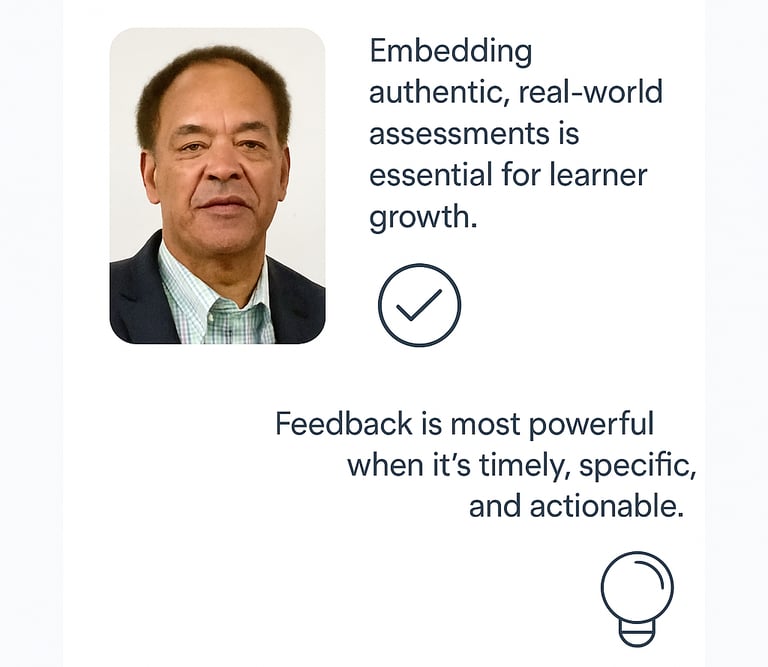

©© 2025 SCM Trainer. Licensed under Creative Commons Attribution-NonCommercial 4.0 International (CC BY-NC 4.0). You may share and adapt this content for non-commercial use with proper attribution.
Learning Theory: Assessment & Learning Models
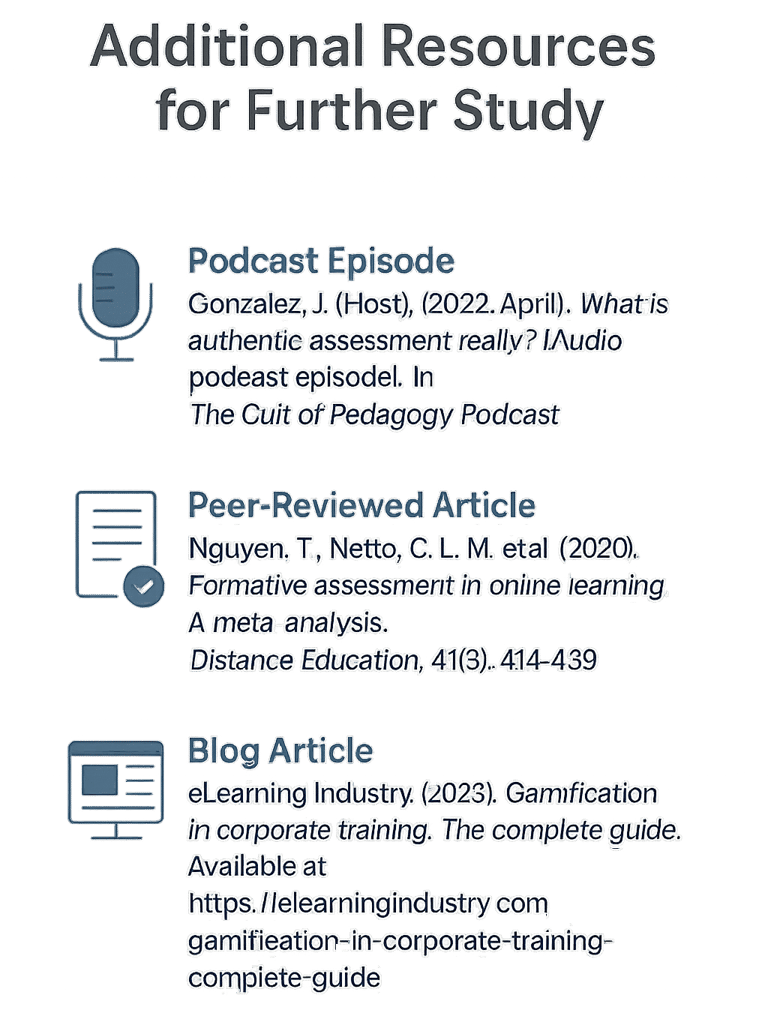

©© 2025 SCM Trainer. Licensed under Creative Commons Attribution-NonCommercial 4.0 International (CC BY-NC 4.0). You may share and adapt this content for non-commercial use with proper attribution.
Microlearning, IDD, & Signature Assignment Submission
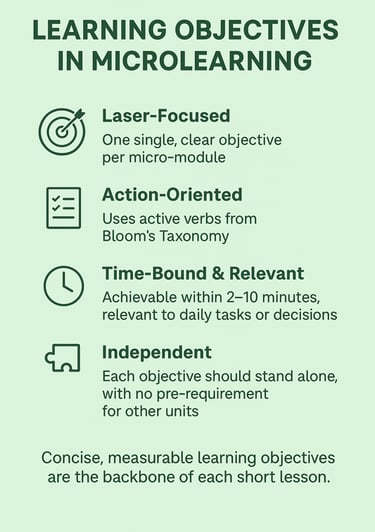

.Overview: Learning Objectives in Microlearning
When we talk about microlearning, we’re talking about more than just making content shorter—we’re talking about making it sharper, more focused, and performance-ready. And nothing anchors that kind of learning better than clear, measurable learning objectives.
In the context of microlearning, learning objectives are not optional. They are essential design tools that keep both the instructional designer and the learner laser-focused. Each microlearning unit is usually 2 to 10 minutes long, so there’s no room for ambiguity or bloated content. You’re not trying to teach everything—you’re trying to teach one thing well.
A strong microlearning objective does three things:
Clarifies the outcome—What exactly should the learner be able to do at the end of this short lesson?
Drives design choices—What content, visuals, or interactions will directly support that outcome?
Enables performance support—Can the learner apply this quickly on the job, in real time?
Unlike traditional training modules, which may have broad or layered objectives, microlearning modules should be scoped to a single, actionable behavior or skill.
©© 2025 SCM Trainer. Licensed under Creative Commons Attribution-NonCommercial 4.0 International (CC BY-NC 4.0). You may share and adapt this content for non-commercial use with proper attribution.
Microlearning, IDD, & Signature Assignment Submission
Role of Learning Objectives in Microlearning
Learning objectives are critical to microlearning because they -
Learning objectives are critical to microlearning because they:
Define the scope and focus of the bite-sized learning activity.
Help the designer ensure each module delivers a clear and measurable takeaway.
Guide the selection of appropriate content, media, and interactions for a narrow learning goal.
Align with broader training goals but are scoped to achievable, standalone outcomes.

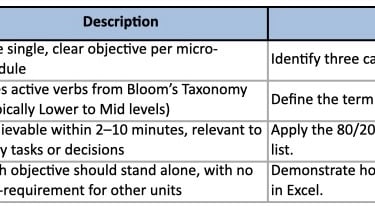
Characteristics of Effective Microlearning Objectives
©© 2025 SCM Trainer. Licensed under Creative Commons Attribution-NonCommercial 4.0 International (CC BY-NC 4.0). You may share and adapt this content for non-commercial use with proper attribution.
Microlearning, IDD, & Signature Assignment Submission
Bloom’s Taxonomy for Microlearning
Microlearning typically focuses on lower- to mid-level Bloom’s domains, such as:
Remembering – Define, list, recall (e.g., terms, steps, policies)
Understanding – Describe, explain, summarize
Applying – Use, demonstrate, perform
Analyzing (less common but possible in short scenario-based modules)
Example: Microlearning Objective - “By the end of this 5-minute video, the learner will be able to identify the three key metrics in a supplier scorecard.”
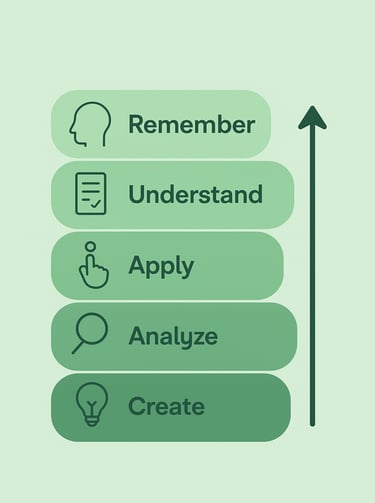

Case Example – SCM Microlearning
Scenario: A 5-minute microlearning video on Inventory Turns for warehouse supervisors.
Objective: “Calculate inventory turnover using a provided dataset.”
Outcome: Learner inputs data into a calculator and sees if it meets benchmark values.
Application: Supports ongoing warehouse KPI improvement efforts.
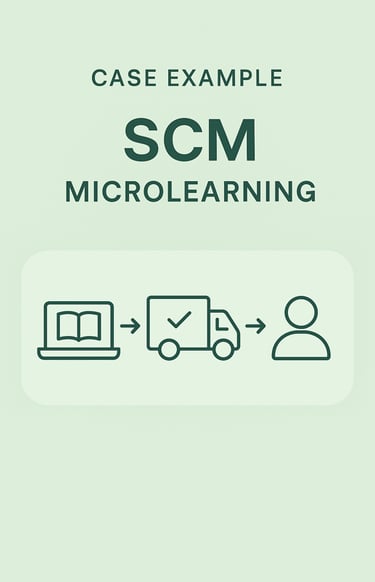

Best Practices for Writing Microlearning Objectives
Write one objective per module.
Start with “By the end of this module, learners will be able to…”
Use performance-based verbs.
Avoid vague verbs like “understand” unless you qualify how it’s demonstrated.
Ensure the objective matches the content length and format.
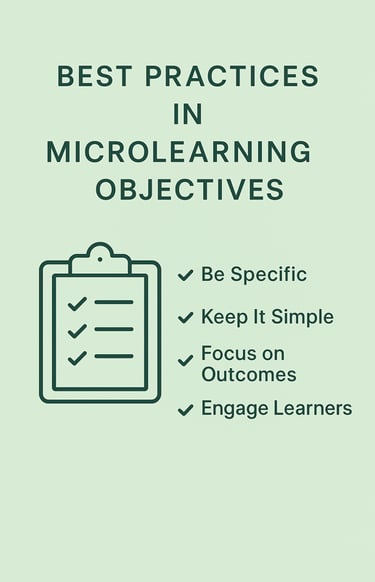

©© 2025 SCM Trainer. Licensed under Creative Commons Attribution-NonCommercial 4.0 International (CC BY-NC 4.0). You may share and adapt this content for non-commercial use with proper attribution.
Microlearning, IDD, & Signature Assignment Submission
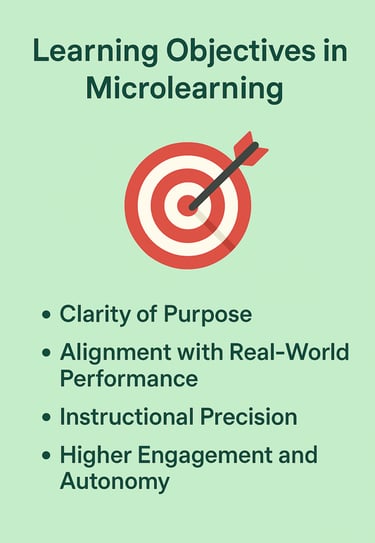

Summary: the role of Learning Objectives in Microlearning
In microlearning, concise, measurable learning objectives are not just a best practice—they are mission-critical. With each module designed to be completed in 2–10 minutes, there’s no room for filler, ambiguity, or vague outcomes. The learning objective acts as the north star—guiding design decisions, focusing content, and defining success for both the learner and the instructional designer.
A well-written microlearning objective ensures:
Clarity of Purpose: The learner knows exactly what they’re supposed to learn or be able to do. This reduces cognitive load and increases focus—two essential ingredients for knowledge retention in short bursts.
Alignment with Real-World Performance: Microlearning works best when tied directly to specific job tasks or behaviors. A strong objective anchors the content to what the learner needs to perform, not just what they need to know.
Instructional Precision: The objective acts as a filter. Only content that directly supports the stated goal should make it into the lesson. This keeps the module lean, relevant, and practical.
Measurable Outcomes: Because each objective is tightly scoped, it’s easier to build assessments that directly evaluate learner progress. Whether it’s a drag-and-drop interaction, quick quiz, or simulation, the evaluation matches the objective—making learning more accountable.
Higher Engagement and Autonomy: Learners are more likely to complete and return to microlearning modules when they can see immediate value. Clear objectives deliver on that promise by making each module feel like a small, achievable win.
©© 2025 SCM Trainer. Licensed under Creative Commons Attribution-NonCommercial 4.0 International (CC BY-NC 4.0). You may share and adapt this content for non-commercial use with proper attribution.
Microlearning, IDD, & Signature Assignment Submission


Article - How to Design Microlearning That Works, Training Industry, https://trainingindustry.com/articles/strategy/how-to-design-microlearning-that-work
Article - Does Microlearning Actually Work?, Work-Learning Research – Dr. Will Thalheimer
https://www.worklearning.com/resources
Blogs - Microlearning: Why Small is the New Big in Training
Ray Jimenez, Vignettes Learning Blog, https://vignetteslearning.com/blog
Videos - What is Microlearning? Explained with Examples
eLearning Industry – YouTube Channel, https://www.youtube.com/watch?v=cB69nbNwrE
Podcasts - Learning Science Weekly – Microlearning Episodes
LearningScienceWeekly.com, https://learningscienceweekly.com
©© 2025 SCM Trainer. Licensed under Creative Commons Attribution-NonCommercial 4.0 International (CC BY-NC 4.0). You may share and adapt this content for non-commercial use with proper attribution.
InstructionalDesign.xyz
a division of SCM Trainer
Raleigh, North Carolina, USA
www.instructionaldesign.xyz
jeffrey@scmtrainer.com